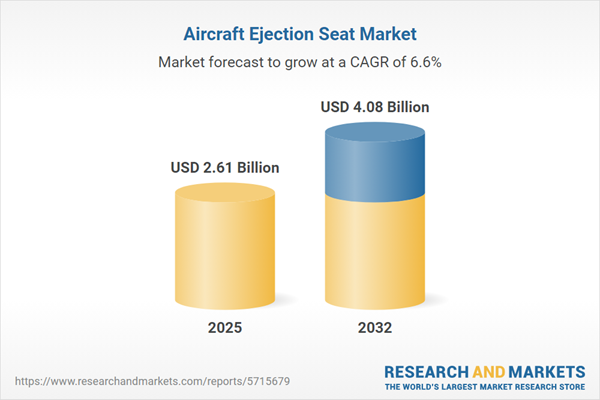Speak directly to the analyst to clarify any post sales queries you may have.
The aircraft ejection seat market is experiencing significant transformation as global aviation stakeholders drive advanced safety initiatives and integrate innovative technologies. Senior decision-makers face evolving challenges as regulatory standards and operational requirements reshape expectations in both military and civil aviation settings.
Market Snapshot: Aircraft Ejection Seat Market Size and Trends
The global aircraft ejection seat market is projected to grow from USD 2.45 billion to USD 4.08 billion between 2024 and 2032, reflecting a CAGR of 6.57%. This expansion is underpinned by sweeping fleet modernization, more stringent regulatory demands, and rapid advancements in safety-critical technology integration. Operators and suppliers are responding by prioritizing modular and future-ready ejection seat solutions that address both established and emerging operational demands. As procurement priorities evolve, regulatory compliance and innovation remain central influences in technology adoption across buyer segments.
Scope & Segmentation of the Aircraft Ejection Seat Market
- Seat Types: Hybrid ejection seats provide modularity, suitable for both new and legacy aircraft. Pyrotechnic models are preferred for simplified operations and reduced maintenance, which addresses cost management. Rocket-assisted seats enhance thrust and durability, aligning well with current sustainability goals in aviation.
- Platforms: The market spans a diverse range of fixed-wing and rotary-wing aircraft, including fighter jets, helicopters, trainers, transport, and utility platforms. Each aircraft type requires tailored ejection seat configurations to meet unique mission needs.
- End Users: Military agencies demand high reliability, customizability, and certification tailored to demanding missions, while civil aviation sectors emphasize compliance, occupant protection, and efficient maintenance adaptability.
- Distribution Channels: Aftermarket services are vital for system upgrades and retrofits. OEM relationships support seamless integration and long-term operational value, providing comprehensive technical support to operators.
- Geographic Regions: Regional dynamics influence procurement and adoption. The Americas, Europe, Middle East and Africa, and Asia-Pacific each present unique manufacturing capacities, regulatory requirements, and procurement landscapes, prompting tailored technology pathways.
- Key Companies: Major companies—including Martin-Baker Aircraft Company Limited, Collins Aerospace, Safran Aerosystems, NPP Zvezda Joint Stock Company, and Aviation Industry Corporation of China—are innovating to align commercial and military sector needs worldwide.
Key Takeaways: Strategic Insights for Procurement Leaders
- Adoption of digital twin and smart sensor technologies supports streamlined fleet upgrades and agile asset management, promoting efficient, data-driven validation of system performance across aircraft fleets.
- Lightweight, flexible seat designs simplify integration and support seamless operational transitions, reducing downtime during fleet changes and ensuring readiness.
- Unified safety coverage is increasingly relevant, with procurement strategies emphasizing adaptable solutions for both manned and unmanned applications.
- Building diverse supplier networks and industry partnerships strengthens supply chain reliability, enabling proactive planning for shifts in policy or material shortages.
- Predictive maintenance and modular upgrades extend the operational lifespan of assets, enabling organizations to quickly adapt to changing mission profiles.
- Localization of technology upgrades is becoming central, allowing procurement teams to align investments with shifting local regulatory and market requirements.
Tariff Impact: Navigating U.S. Policy Shifts and Supply Chain Resilience
Recent U.S. tariff changes on aircraft components have introduced additional cost and supply chain pressures. In response, industry leaders are prioritizing broader supplier relationships and enhancing domestic stockpiles to ensure operational continuity. Increased regional collaboration aims to strengthen compliance and boost resilience against uncertainties or disruptions in global supply flows.
Methodology & Data Sources
This analysis is grounded in extensive desk research and expert interviews focused on aviation engineering and procurement. Insights were reviewed and validated by a technical panel, ensuring relevance and accuracy for procurement executives and strategy leaders.
Why This Report Matters
- Helps procurement teams craft acquisition strategies that reflect evolving safety requirements and regulatory frameworks in military and civil aviation.
- Provides actionable insights on operational and policy changes, supporting resilient, data-driven sourcing decisions.
- Enables leaders to proactively assess supplier risk and develop supply chain strategies as compliance demands and industry norms shift.
Conclusion
This report equips senior leaders with a clear understanding of current developments, empowering them to navigate regulatory changes, strengthen procurement processes, and maintain operational resilience within the aircraft ejection seat sector.
Additional Product Information:
- Purchase of this report includes 1 year online access with quarterly updates.
- This report can be updated on request. Please contact our Customer Experience team using the Ask a Question widget on our website.
Table of Contents
3. Executive Summary
4. Market Overview
7. Cumulative Impact of Artificial Intelligence 2025
Companies Mentioned
The companies profiled in this Aircraft Ejection Seat market report include:- Martin-Baker Aircraft Company Limited
- Collins Aerospace
- Safran Aerosystems
- NPP Zvezda Joint Stock Company
- Aviation Industry Corporation of China
Table Information
| Report Attribute | Details |
|---|---|
| No. of Pages | 197 |
| Published | October 2025 |
| Forecast Period | 2025 - 2032 |
| Estimated Market Value ( USD | $ 2.61 Billion |
| Forecasted Market Value ( USD | $ 4.08 Billion |
| Compound Annual Growth Rate | 6.5% |
| Regions Covered | Global |
| No. of Companies Mentioned | 6 |









